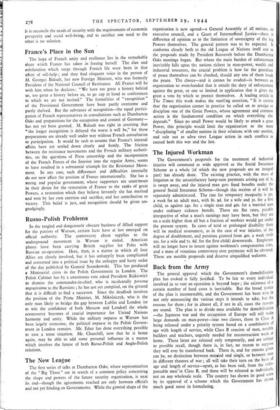The New League
The first series of talks at Dumbarton Oaks, where representatives of the " Big Three " are in search of a common policy concerning the shape and powers of the future security organisation, is near its end—though the agreements reached are only between officials and not yet binding on Governments. While the general shape of the
organisation is now agreed—a General Assembly of all nations, an executive council, and a Court of Internattutal Justice—there is
difference of opinion as to the limitation of sovereignty of the big Powers themselves. The general pattern was to be expected. It conforms closely both to the old League of Nations itself and to the proposals made by President Roosevelt before the Dumbarton Oaks meetings began. But where the main burden of enforcement inevitably falls upon the nations richest in man-power, wealth and industrial resources, the crucial problem is how far the guardians of peace themselves can be checked, should any one of them break the peace. The choice—and it cannot be evaded—is between an organisation so even-handed that it entails the duty of enforcement against the great, or one so limited in application that it gives the great a veto by which to protect themselves. A leading article in The Times this week makes the startling assertion, " It is certain that the organisation cannot in practice be called on to arraign or discipline one of the Great Powers, whose agreement and common action is the fundamental condition on which everything else depends." Since no small Power would be likely to attack a great Power, this principle would limit the organisation to the mere " disciplining " of smaller nations in their relations with one another, and rule out as ultra wires League action in such conflicts as caused both this war and the last.


























 Previous page
Previous page